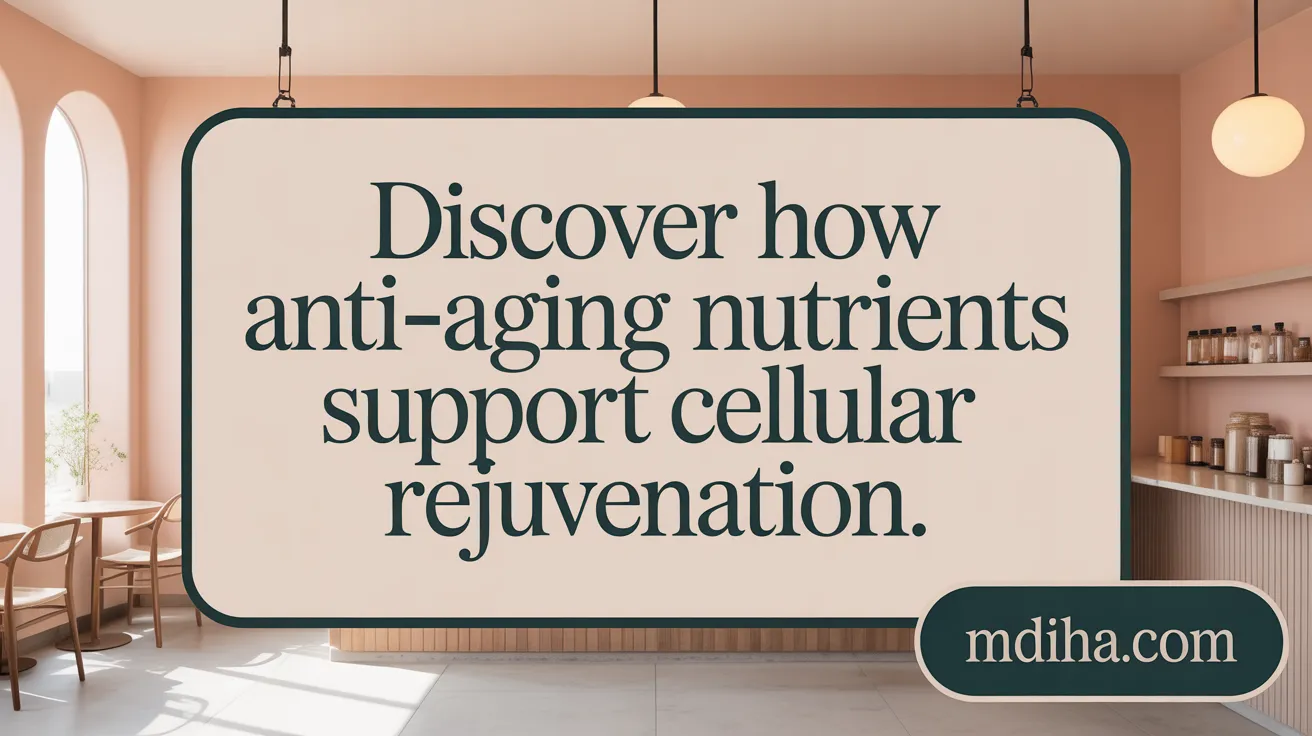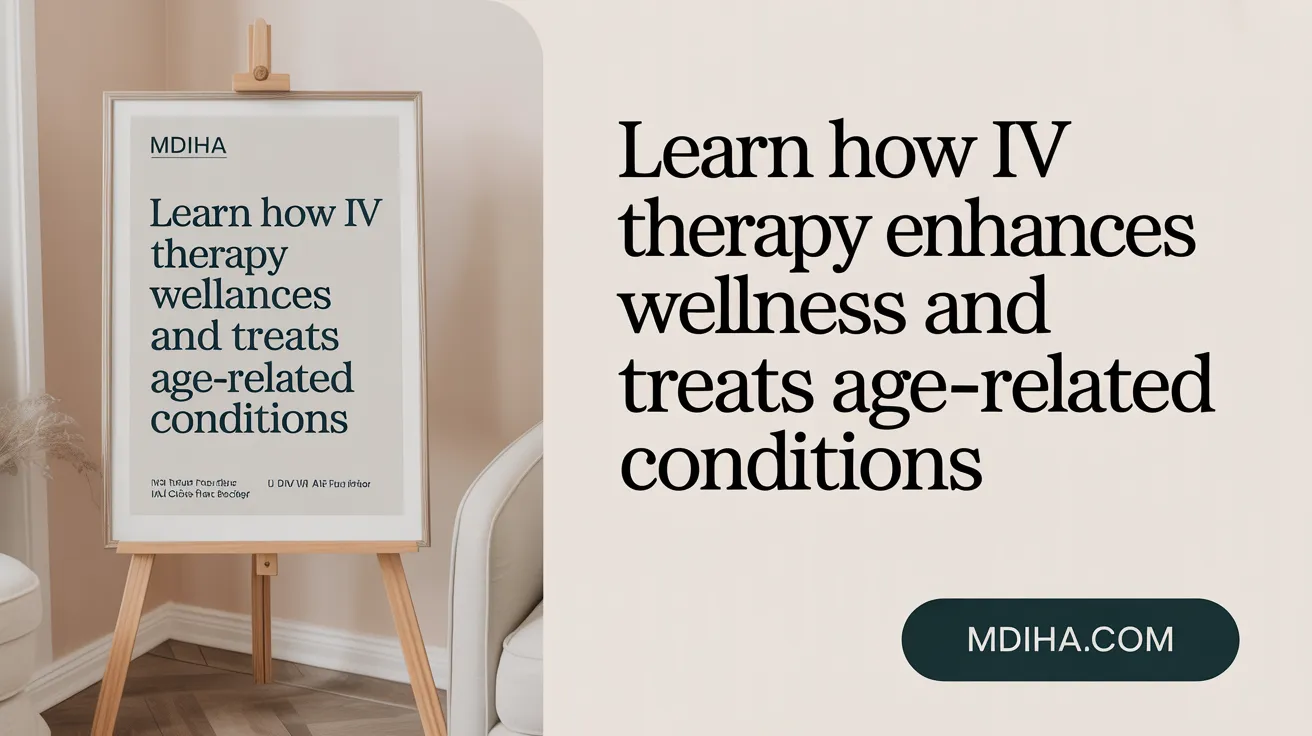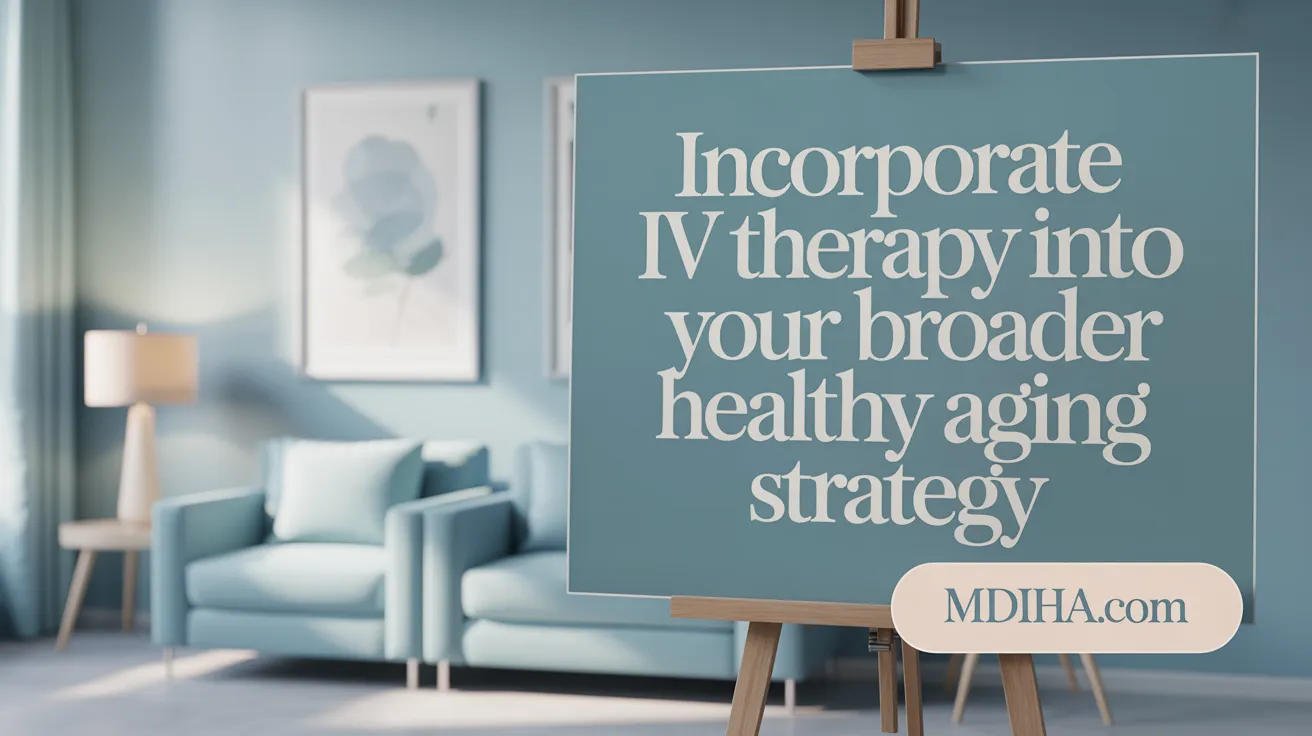The Emerging Role of IV Therapy in Healthy Aging
Intravenous (IV) therapy has gained considerable attention as a potential tool for healthy aging, delivering vital nutrients directly into the bloodstream for rapid and effective absorption. This article unpacks the science behind IV therapy and examines its benefits and risks, particularly for seniors and aging adults seeking to maintain vitality, hydration, and cellular health through advanced nutrient delivery methods.
How IV Therapy Enhances Nutrient Absorption in Aging Adults
How does IV therapy deliver nutrients more effectively than oral supplements?
IV therapy bypasses the gastrointestinal (GI) tract by injecting nutrients directly into the bloodstream. This method results in nearly 100% bioavailability and rapid absorption of essential vitamins, minerals, and antioxidants. In contrast, oral supplements must pass through the digestive system, where factors such as digestive inefficiency, gastrointestinal disorders, enzyme deficiencies, medication interactions, and age-related changes can significantly reduce the amount of nutrients absorbed.
Why is IV nutrient delivery particularly beneficial for seniors?
With aging, digestive efficiency and stomach acid production decline, leading to reduced absorption of vital nutrients from food and oral supplements. IV therapy circumvents these limitations by providing immediate and direct nutrient delivery into the bloodstream. This is especially important for older adults who may face malabsorption issues, diminished appetite, or chronic health conditions. Learn more about the benefits of IV therapy for seniors.
What are the bioavailability advantages of IV therapy over oral supplements?
- Nearly 100% nutrient absorption
- Avoidance of first-pass metabolism in the liver
- Ability to reach plasma nutrient levels unattainable by oral intake
- Rapid onset of effects
What challenges affect nutrient absorption in older adults?
- Decreased digestive enzyme production
- Reduced stomach acid levels
- Gastrointestinal disorders (e.g., celiac disease, inflammatory bowel disease)
- Medication interactions
- Loss of taste and smell leading to decreased appetite
- Age-related malabsorption syndromes
See more on IV vitamin therapy for malabsorption issues and nutrient challenges.
What common nutrients are delivered via IV therapy for aging populations?
- Vitamin C: Supports immune function and collagen production
- B Vitamins (especially B12 and B complex): Boost energy metabolism and cognitive function
- Magnesium and Calcium: Support muscle, nerve health, and bone strength
- Zinc: Enhances immune response
- Glutathione: Powerful antioxidant for cellular repair
- NAD+: Supports cellular energy and DNA repair
By delivering these nutrients directly into the bloodstream, IV therapy provides aging adults with an effective means to maintain vital nutrient levels, combat fatigue, boost immunity, and support overall health. For detailed insights on nutrient delivery and healthy aging with IV vitamin therapy and anti-aging IV treatments including NAD+ and glutathione.
Key Benefits of IV Therapy for Seniors and Healthy Aging

What are the primary health benefits of IV therapy for seniors?
IV therapy delivers fluids, vitamins, and minerals directly into the bloodstream, offering seniors rapid rehydration that prevents severe dehydration—a common risk due to their reduced body water and diminished thirst. By bypassing the digestive system, it efficiently corrects nutrient deficiencies such as low vitamin B12, vitamin C, and magnesium. This results in immediate energy boosts and fatigue reduction, helping older adults maintain vitality (Benefits of IV Therapy for Seniors).
In addition, IV therapy supports the immune system through antioxidants like vitamin C and glutathione, protecting seniors from infections and oxidative stress (IV Drip Therapy). Nutrient delivery also benefits cognitive function, aiding in clearer mental focus and reducing brain fog often linked to aging (IV therapy for seniors). Improvements in skin health arise from enhanced hydration and collagen production, contributing to a youthful appearance and addressing visible signs of aging (Anti-Aging IV Infusion).
How does IV hydration specifically support healthy aging?
Chronic dehydration affects up to 40% of seniors, caused by factors like less water stored in the body and a weakened thirst response. This can lead to symptoms such as confusion, dizziness, reduced urination, and increased risk of falls. IV hydration quickly restores fluid and electrolyte balance by delivering these elements directly into the bloodstream, bypassing the slower oral absorption (IV drip for hydration).
This fast rehydration stabilizes vital physiological functions, supports recovery from illness, and improves skin hydration and elasticity. Additionally, it helps reduce complications linked to dehydration such as urinary tract infections and kidney problems, thereby contributing to overall healthier aging (Benefits of IV Therapy for Seniors.
| Benefit Area | Specific Effects | Description |
|---|---|---|
| Hydration | Rapid rehydration | Prevents dehydration-related symptoms and health risks (IV infusion therapy for seniors) |
| Nutrient Correction | Vitamin B12, C, magnesium replenishment | Corrects deficiencies for energy and immune support (IV vitamin therapy benefits) |
| Energy & Fatigue | Immediate energy boosts | Combats age-related fatigue and supports metabolic function (IV vitamin therapy effects) |
| Immune & Cognitive | Antioxidant delivery, cognitive clarity | Enhances immunity and mental performance (IV therapy for seniors |
| Skin & Anti-Aging | Collagen production, antioxidant support | Improves skin elasticity, reduces wrinkles (Anti-Aging IV Infusion |
Anti-Aging Nutrient Cocktails and Their Cellular Impact

What key nutrients in anti-aging IV infusions support healthy aging?
Anti-aging IV therapy infusions contain a blend of powerful nutrients tailored to support longevity and overall cellular health. These include NAD+, which activates sirtuin genes associated with metabolism and DNA repair, enhancing cellular energy. Glutathione acts as a master antioxidant, defending cells from oxidative damage. Essential amino acids such as L-arginine, L-carnitine, and L-lysine contribute by improving cardiovascular function, boosting energy metabolism, and promoting collagen synthesis. Additionally, alpha-lipoic acid helps improve insulin sensitivity and counters inflammation, complementing the therapy’s anti-aging effects.
How do these nutrients contribute to slowing the aging process?
The various nutrients in these IV cocktails work synergistically to promote cellular repair and longevity. Mitochondrial function is enhanced, leading to better energy production and cell rejuvenation. Antioxidant components like glutathione neutralize damaging free radicals, reducing cellular oxidative stress and inflammation, a key factor in age-related degeneration. Moreover, amino acids such as L-lysine boost collagen production, supporting skin elasticity and youthful appearance. Together, these compounds help maintain muscle and tissue integrity while strengthening immune function, ultimately contributing to slower aging and improved vitality.
Clinical and Wellness Applications of IV Therapy in Aging Populations

In what medical scenarios is IV therapy used for seniors?
IV therapy plays an essential role in managing several health challenges common among seniors. It is especially vital for treating dehydration, which frequently occurs in older adults due to reduced body water and impaired thirst response. The therapy rapidly replenishes fluids and electrolytes, preventing severe complications such as urinary tract infections and kidney issues (benefits of IV Therapy for seniors, IV drip for hydration.
Moreover, malnutrition is a significant concern in seniors, partly because aging reduces taste and smell, lowering appetite. IV therapy effectively delivers essential nutrients like vitamin B12, magnesium, and vitamin C directly into the bloodstream, ensuring adequate nutritional status even with gastrointestinal absorption difficulties or swallowing problems (IV nutritional therapy advantages, IV infusion therapy benefits for seniors. It also facilitates efficient administration of medications for those unable to take oral drugs, including during chronic illness management and recovery after surgery (Administering medications via IV, Home infusion therapy).
How is IV therapy integrated into wellness and aging-in-place strategies?
IV therapy extends beyond treating acute medical conditions and is used for wellness purposes in seniors. It offers benefits such as boosting energy levels, enhancing immune function, improving hydration, and supporting skin health through nutrient-rich infusions (Enhanced immune function from IV therapy, IV therapy for hydration and recovery, Anti-aging IV infusion. Specialized formulations aim to promote cellular health, collagen production, and reduce oxidative stress, potentially slowing visible signs of aging (Nutrient infusion benefits, Anti-aging benefits of IV therapy).
Importantly, IV therapy can be safely delivered at home with skilled nursing care. This home-based approach provides convenience and comfort, reduces hospital visits, and supports seniors who wish to age in place (Safe home IV therapy for seniors, Home infusion therapy coordination. Trained healthcare professionals ensure proper evaluation, sterile technique, and close monitoring to minimize risks such as infection, allergic reactions, and fluid overload, thus enhancing both safety and effectiveness (Safety of IV therapy in seniors, IV infusion therapy safety protocols).
Safety considerations in older adults
While generally safe when managed by qualified professionals, IV therapy in seniors requires careful oversight due to potential risks like bruising, allergic reactions, vein damage, and electrolyte imbalances (Risks and safety of IV therapy, IV vitamin therapy risks). Continuous monitoring during administration and appropriate patient evaluation help mitigate these risks (Managing IV therapy side effects, Safety considerations of IV vitamin therapy. Customized treatments and adherence to sterile protocols further support patient safety and maximize therapeutic outcomes (Proper sterile techniques in IV therapy.
Potential Risks, Evidence, and Cost Considerations of IV Therapy

What are the potential risks associated with IV vitamin therapy?
IV vitamin therapy carries several potential risks including infection, vein damage, thrombophlebitis (vein inflammation), and allergic reactions. Electrolyte imbalances and fluid volume overload are other concerns, especially if the therapy is not properly managed. Rare complications from IV line insertion, such as trauma and bleeding, can also occur. These risks are significantly minimized when the procedure is performed by qualified healthcare professionals using sterile techniques. For more details on the risks of intravenous vitamin treatment and safety considerations of IV vitamin therapy, see these resources.
How strong is the scientific evidence supporting IV therapy for healthy individuals?
Although IV therapy is clinically effective for patients with medical conditions like malabsorption syndromes or post-surgical nutrient deficiencies, scientific support for its use in healthy individuals remains limited. Most evidence in wellness contexts is anecdotal, with few rigorous, large-scale studies validating benefits. More research is needed to assess long-term safety, optimal dosages, and how IV therapy compares with oral supplementation or placebo effects. For an overview of the scientific evidence on IV vitamin therapy and future research on IV vitamin therapy, refer to these articles.
What should individuals consider before pursuing IV therapy?
People considering IV vitamin therapy should consult their healthcare providers to understand the balance of benefits and risks. It is important to discuss any possible interactions with current medications and to consider lifestyle factors proven to support health, such as a nutritious diet, regular exercise, adequate sleep, and maintaining social connections. Additionally, the cost of IV therapy, which often ranges between $250 and $800 per session and may not be covered by insurance, should be carefully evaluated against the therapy’s clinical necessity and potential advantages. For guidance on IV vitamin therapy benefits and risks and advice on consulting healthcare professionals about IV vitamin therapy, see these resources.
Integrating IV Therapy into a Holistic Healthy Aging Plan

How does IV therapy fit into a comprehensive approach to healthy aging?
IV therapy acts as a beneficial support within a broad, holistic healthy aging strategy. While it offers rapid and effective delivery of essential nutrients, hydration, and antioxidants, it should complement—not replace—fundamental lifestyle practices. Those foundational elements include a balanced, nutrient-rich diet, regular physical exercise, adequate sleep, stress reduction techniques, and strong social interactions. Together, these lifestyle factors create the primary framework for maintaining health and vitality in older adults.
IV therapy can help address specific nutritional deficiencies, support immune function, boost energy levels, and improve hydration status, especially in situations where oral intake or absorption is impaired. However, it works best as part of comprehensive care plans tailored to individual needs, enhancing outcomes without negating the importance of established healthy aging behaviors. See more on benefits of IV vitamin therapy and IV therapy for seniors.
Complementary lifestyle strategies
Holistic healthy aging embraces multiple lifestyle components:
- Nutrition: Whole foods provide necessary vitamins, minerals, and antioxidants vital for cellular health.
- Physical activity: Consistent exercise enhances cardiovascular fitness, muscle strength, and cognitive function.
- Sleep hygiene: Quality sleep supports recovery, hormonal balance, and brain health.
- Stress management: Techniques like mindfulness or social support reduce inflammation and promote emotional wellbeing.
- Social engagement: Maintaining relationships sustains mental health and resilience.
Integrating IV therapy within this lifestyle framework maximizes potential benefits and supports sustainable healthy aging. Learn about anti-aging IV infusion benefits and the role of IV therapy in anti-aging and wellness.
Customized IV therapy within comprehensive care
IV therapy can be personalized based on an individual's health status, nutritional needs, and aging concerns. Medical evaluation including blood testing guides the selection of nutrients such as B vitamins, vitamin C, magnesium, antioxidants like glutathione, and NAD+, all of which play roles in immune support, energy metabolism, and cellular repair.
This individualized approach ensures that IV treatments effectively address deficiencies or specific symptoms while aligning with the patient’s overall health goals. Professional oversight is essential to safely administer therapy and monitor responses. For detailed insights, see personalized vitamin cocktails and IV nutrient absorption and NAD+ and anti-aging IV therapy.
What future developments are needed in IV therapy research?
To better define the role of IV therapy in healthy aging, future research should include:
- Long-term studies assessing safety and sustained effectiveness.
- Standardized dosing protocols to optimize nutrient delivery.
- Direct comparisons between IV therapy and oral supplementation to determine relative benefits.
- Placebo-controlled trials to delineate true therapeutic effects.
- Development of comprehensive clinical guidelines to assist healthcare providers in integrating IV therapy responsibly.
Such advancements will help clarify where IV therapy fits best within aging wellness plans and improve evidence-based practice for this growing population. For further context, review clinical evidence and limitations of IV vitamin therapy and scientific evidence on IV vitamin therapy.
This integrated perspective underscores IV therapy as a valuable adjunct within a holistic healthy aging regimen rather than a standalone solution.
Balancing Promise and Prudence: The Future of IV Therapy in Aging
IV therapy offers a scientifically grounded method to efficiently deliver vital nutrients and hydration directly into the bloodstream, presenting tangible benefits for older adults facing absorption challenges, malnutrition, or dehydration. Targeted anti-aging infusions enriched with antioxidants, amino acids, and NAD+ hold promise for cellular rejuvenation and enhancing vitality. However, the limited robust evidence supporting widespread wellness use, coupled with potential risks and substantial costs, calls for cautious, informed decision-making. Integrating IV therapy as one component within a holistic healthy aging strategy—emphasizing nutrition, exercise, sleep, and social well-being—offers the most balanced path forward. Continued rigorous research will be critical to fully define IV therapy's role in promoting graceful, healthy aging.
